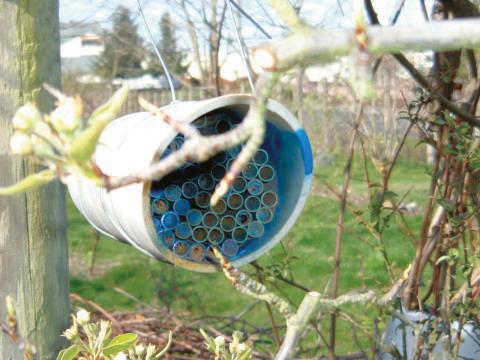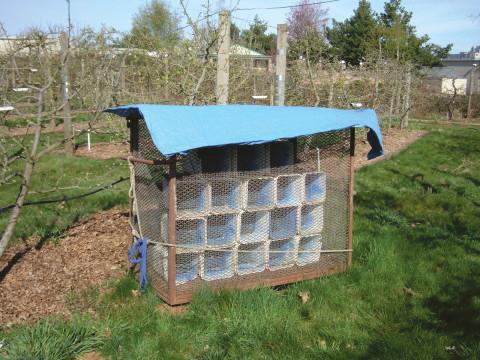Mason bee nests require protection from moisture, wind, and direct summer sunlight. In addition, nest shelters serve as a visual landmark for bees returning from foraging trips. Once installed, shelters and partially filled nests MUST NOT be moved during the nesting season. Any movement will result in disorientation for nesting bees and high numbers of bees drifting to other nesting sites.

A significant amount of research has been performed on field shelters for alfalfa leafcutter bee nests, and the same principles apply to mason bee shelters. The most important of those principles is size. A common mistake that mason beekeepers make is the use of shelters that are too small, or worse, not using any shelter at all (by attaching drilled blocks or bundles of reeds directly onto trees or fence posts) (Figure 6.18). Small shelters are difficult for nesting female bees to locate in the landscape. Instead, large profile shelters act like billboards for returning bees. Large shelters also provide basking areas for bees to warm themselves during cold spring mornings before flight and protection from high wind velocities which hamper nesting.
Freestanding leafcutter shelters used in the Canadian provinces are commonly 6 to 10 feet high, by 8 feet wide and 4 feet deep (~1.8 to 3 meters high, by 2.4 meters wide and 1.2 meters deep) (Figure 6.19). Commercially produced structures include tent-like shelters with metal frames and fabric sides, as well as molded plastic dome shelters. However, many beekeepers also construct their own plywood shelters. Any of these designs are excellent for mason bees, however slightly smaller designs, as necessary for orchard conditions, are also acceptable. Shelters deeper than 3 to 4 feet (0.9 to 1.2 meters) remain dark and are less attractive to bees. Regardless of design, freestanding shelters are easily toppled in strong winds unless firmly secured to the ground.

If small shelters are used they should be grouped together to form a landmark, or they should be placed against a barn wall or some other large structure. Conversely an open barn or shed directly adjacent to the field can be used as a shelter with the nests hung inside the building.
Shelters should also be painted in colors that contrast with the landscape. Contrasting light and dark vertical lines or other paint patterns may be helpful visual cues for returning bees.
Since foraging activity increases under high light intensity, shelters should face east or southeast if possible so that they capture sunlight early in the day. Direct sunlight is fine in early spring, but it is not favorable in the summer and can overheat larvae inside finished nests. Temperatures higher than 90°F (32.2°C) can be lethal to developing bee larvae. Similarly shelters that receive direct sunlight in late winter may result in emergence before sufficient forage is available.
The nests can be left in the shelter year-round where the bees will develop and emerge naturally at ambient temperatures. As stated earlier, some type of phase-out system should be employed to prevent bees from re-nesting in previously used nests. Such systems can be incorporated into the shelter design, employing a closed off compartment with a single exit hole. Bees (and parasites) are attracted to light entering the hole and will exit the phase-out chamber into the larger shelter where clean empty nests are installed. After the emergence period ends, the old nests can be removed from the phase-out chamber and cleaned. Shelters left in the field year-round should be loosely attached to ground anchors during the winter months to prevent damage from frost heaving.
Shelters may also need to be secured against predators. Ants and earwigs are a common problem. In freestanding shelters, they can be discouraged by coating the shelter legs with automotive grease. Woodpeckers, barn swallows, other birds, as well as squirrels, can all become a nuisance. Birds can be excluded if necessary using plastic netting with the largest mesh size possible. The netting should be pulled tautly. Metal mesh should not be used as it can damage the bee’s wings. Various bird-scare devices may also be sufficient; mesh should only be used as a last resort.
Finally, just because a shelter can accommodate a large number of nests doesn’t necessarily mean it should. There is some good evidence to suggest that shelter crowding results in fierce nest tunnel competition which stresses bees. This crowding may also translate into higher levels of chalkbrood disease and parasites. A minimum of two empty nest tunnels per female bee should be provided each season. More is better.
